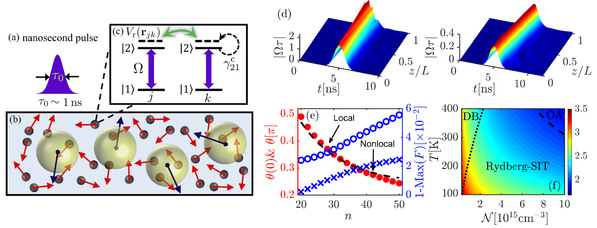The research group led by Professor Guoxiang Huang from the State Key Laboratory of Precision Spectroscopy (ECNU) has made a significant advance on the investigation of Rydberg nonlinear optics. The group predicted that the stable propagation of optical pulses in strongly interacting Rydberg atomic gases working at room temperature can be realized through a self-induced transparency (SIT) effect. The research result has been published recently in Physical Review Letters, with the article title “Self-Induced Transparency in Warm and Strongly Interacting Rydberg Gases.” [Zhengyang Bai et al., Physical Review Letters 125, 263605 (2020)]. This work was collaborated with Prof. Weibin Li from the University of Nottingham and Prof. Charles Adams from Durham University, UK. Dr. Zhengyang Bai, a young researcher of the research group, is the first author of the article.

The research achievement of Guoxiang Huang group on Rydberg nonlinear optics was published recently in Physical Review Letters
Rydberg atoms are a class of highly-excited-state atoms with very large orbit radius. There exist very strong long-range interactions between Rydberg atoms, which have values of more than ten times larger than those between ground-state atoms and can be controlled actively. By exploiting techniques of coherent light manipulations, the strong long-range interactions between Rydberg atoms can be converted into the strong nonlocal interactions between photons, which can be used to realize the Rydberg blockade of atomic excitations and hence can apply to many research fields, including quantum compution and quantum information, precision spectroscopy and precision measurement, nonlinear and quantum optics, and non-equilibrium quantum many-body simulations, etc.
Due to the existence of various (including Doppler, collision, transit-time) effects of spectral broadening, at room temperature the interactions between Rydberg atoms are suppressed by the decoherent effect resulted from atomic thermal motions. Thus it is difficult to acquire strong and coherent nonlinear and quatum optical effects. Based on their interesting physical properties and potential applications, explorations on room-temperature Rydberg atomic gases were made by many research groups in the world. But how to acquire strong, coherent, nonlinear and quantum optical effects at nanosecond timescale and at room temperature remains a problem to be solved urgently.

(a)-(c) Schematic of physical model of Rydberg-SIT
(d) Propagation dynamics of nanosecond pulses in the Rydberg atomic gas
(e)SIT area theorem relying on the atomic interaction
(f) Phase diagram of the Rydberg-SIT for different temperatures and atomic densities
Guoxiang Huang group proposed a scheme for realizing stable propagations of nanosecond optical pulses in a room-temperature Rydberg atomic gas by using SIT effect. By a deep analysis on the relation between atomic collision cross-section and atomic temperature, quantum number, and energy-state decay rates, and by carefully solving the nonlinear equations of motion describing the interaction between optical pulses and the atoms, they revealed the SIT characters of coherent propagations of the optical pulses in the Rydberg atomic gas working at room temperature, and presented a new area theorem that depends on the interatomic interaction. Their research results paved a new way for realizing strong, coherent, nonlinear and quantum optical effects and for their applications in optical and quantum information processing based on Rydberg atomic gases. Their research was supported by the Natural Science Foundation of China and Shanghai Talent Programs.

The research result of Guoxiang Huang Group was published in Optica
Guoxiang Huang group, long been engaged in researches on nonlinear physics, nonlinear optics, and their applications, has in recent years focused on their efforts on the nonlinear and quantum optical effects in ultracold Rydberg atomic gases, and made a series of research achievements. In 2019, based on the nonlocal and long-range interaction between photons induced by the long-range interaction between Rydberg atoms, they predicted that high-dimensional nonlinear optical pulses can propagate stably and manipulated actively in ultracold Rydberg atomic ensembles, including high-efficiency and high-fidelity storage and retrieval. The related research result was published in Optica [Zhengyang Bai et al., Optica 6, 309-317 (2019)].
论文链接:https://journals.aps.org/prl/abstract/10.1103/PhysRevLett.125.263605
Source: State Key Laboratory of Precision Spectroscopy
Editor: Yuan Yiwei


















